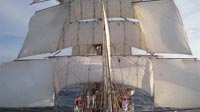 This isn’t a new, but I find it fascinating nevertheless. Larger than the giant squid, the colossal squid has never been seen alive. Two years ago an autopsy was performed in New Zealand on the biggest intact colossal squid ever collected.
This isn’t a new, but I find it fascinating nevertheless. Larger than the giant squid, the colossal squid has never been seen alive. Two years ago an autopsy was performed in New Zealand on the biggest intact colossal squid ever collected.
The Norwegian Government has announced that the wreck of the WW2 German submarine U-864, which contains 65 tons of mercury, is to be raised, and that the contaminated seabed be covered with clean sand. The submarine, which lies off the Norwegian west coast near Fedje, north of Bergen, has long been considered an environmental hazard by environmental groups and local people.
Continue reading
 We have posted extensively about the oldest just barely surviving composite clipper ship, the City of Adelaide, which is in danger of being broken up in May. We have also noted the arguments over the HMAS Adelaide, which may or may not be sunk as an artificial reef. Now, with thanks to Dick Kooyman, we have learned of another City of Adelaide at risk of being moved to a local dump.
We have posted extensively about the oldest just barely surviving composite clipper ship, the City of Adelaide, which is in danger of being broken up in May. We have also noted the arguments over the HMAS Adelaide, which may or may not be sunk as an artificial reef. Now, with thanks to Dick Kooyman, we have learned of another City of Adelaide at risk of being moved to a local dump.
 Kalmar Nyckel crew readies for spring sailing
Kalmar Nyckel crew readies for spring sailing
You can’t cobble up in a book all of what Captain Lauren Morgens and the 20-plus crew members who will be traveling abroad the Kalmar Nyckel for several months have learned from being on the ship.
Continue reading
 Pigeon Forge, Tennessee is a small town located in the Great Smokey Mountains of Tennessee, located just north of the Great Smokey National Park. It is one of the more unlikely locales in which to find a half scale recreation of the Titanic opening in early April as a “Museum/Attraction.” Then again Pigeon Forge is not your typical mountain hamlet either. It has a population of somewhere over 5,000 but is visited by 11 million tourists each year. It’s largest draw may be “Dollywood” a theme park owned in part by country music singer Dolly Parton, well know for her big hair, breasts, and voice. The town is also a center for car shows and various music and entertainment venues.
Pigeon Forge, Tennessee is a small town located in the Great Smokey Mountains of Tennessee, located just north of the Great Smokey National Park. It is one of the more unlikely locales in which to find a half scale recreation of the Titanic opening in early April as a “Museum/Attraction.” Then again Pigeon Forge is not your typical mountain hamlet either. It has a population of somewhere over 5,000 but is visited by 11 million tourists each year. It’s largest draw may be “Dollywood” a theme park owned in part by country music singer Dolly Parton, well know for her big hair, breasts, and voice. The town is also a center for car shows and various music and entertainment venues.
Titanic museum to open: Regis Philbin to host grand opening for $25 million attraction
Continue reading
Chinese Freighter Slams Into Great Barrier Reef
The Shen Neng 1 crashed into the reef at full speed a few hours after leaving the port of Gladstone, the Australian authorities said. The ship, which was nine miles outside its authorized shipping lane, was hauling 72,000 tons of coal and had 1,000 tons of bunker fuel aboard.
Australian officials warned that the vessel was in danger of breaking apart, and there were reports on Sunday night of traces of oil leaking from the vessel. An Australian aircraft reportedly dropped chemical dispersants on the oil.
 Pirate Latitudes by Micheal Crichton, published a year after his death, is a romp. It is full of swashbuckling action and completely familiar characters. There is a bold captain, who is either a privateer or a pirate; several fair and comely maidens of high birth and low; and a band of adventurers each with special skills and powers.
Pirate Latitudes by Micheal Crichton, published a year after his death, is a romp. It is full of swashbuckling action and completely familiar characters. There is a bold captain, who is either a privateer or a pirate; several fair and comely maidens of high birth and low; and a band of adventurers each with special skills and powers.
The rough and tumble hero, Captain Charles Hunter, sets off to capture a Spanish galleon laden with treasure, at anchor under the guns of an impregnable fortress.
Continue reading
 Barista Uno at the Marine Café Blog shares his perspective on ” downside and upside, the agony and joy, of maritime blogging.”
Barista Uno at the Marine Café Blog shares his perspective on ” downside and upside, the agony and joy, of maritime blogging.”
Confessions of a maritime blogger
The Marine Café Blog was launched in late August of 2009, succeeding the old Marine Café news website. This makes bllogging a fairly new game for us, although we were into international maritime journalism long before some of the manning fellas in Manila became rich and started driving around town in Mitsubishi Pajeros and Ford Expeditions. Seven months is a short time but enough for us to see the downside and upside, the agony and joy, of maritime blogging.
Continue reading
We have previously posted about the sinking of the school ship Concordia in February off the coast of Brazil. Now, after examining satellite data and weather reports, a U. S. meteorologist, Ken Pryor of the National Oceanic and Atmospheric Administration, has concluded that the school ship Concordia was probably struck by a “microburst,” confirming earlier speculation.
U.S. expert says microburst hit N.S.-based sailing school that sank off Brazil
Continue reading
 On April 14th Turk Film Services will be holding an online auction of up to 200 boats and floating craft ranging from the Cygnet, an iron steam launch built in 1873 to a “swan boat” which features a detachable fiberglass swan built onto a double ended Swedish sailing dinghy. The auction features a highly eclectic mix of water craft including boats used in the television and movie productions of Hornblower, Harry Potter, Swallows and Amazons, 633 Squadron and Three Men in a Boat.
On April 14th Turk Film Services will be holding an online auction of up to 200 boats and floating craft ranging from the Cygnet, an iron steam launch built in 1873 to a “swan boat” which features a detachable fiberglass swan built onto a double ended Swedish sailing dinghy. The auction features a highly eclectic mix of water craft including boats used in the television and movie productions of Hornblower, Harry Potter, Swallows and Amazons, 633 Squadron and Three Men in a Boat.
 Transoceanic Sailboat Race Kicking Off in NYC
Transoceanic Sailboat Race Kicking Off in NYC
Six sailors are looking to make history. Two sailboats, the W Hotels and Estrella Damm, docked in New York harbor will set off for Barcelona, Spain, early next month. They are racing against each, as well as history.
Continue reading
 Professional surfer and Stand Up Paddleboard (SUP) ambassador Jodie Nelson became the first woman to paddle 39.8 grueling miles from the island of Catalina to Dana Point in an effort to raise awareness and funds for breast cancer research and prevention. She has an unexpected escort for two hours of the nine hour paddle. A 30 foot minke whale swan beside her 14 foot board, often rolling and blowing bubbles and around and under it.
Professional surfer and Stand Up Paddleboard (SUP) ambassador Jodie Nelson became the first woman to paddle 39.8 grueling miles from the island of Catalina to Dana Point in an effort to raise awareness and funds for breast cancer research and prevention. She has an unexpected escort for two hours of the nine hour paddle. A 30 foot minke whale swan beside her 14 foot board, often rolling and blowing bubbles and around and under it.
California surfer receives whale of an escort during marathon paddle
Continue reading
 The moral of the story may be to identify the ship before you attack it.
The moral of the story may be to identify the ship before you attack it.
U.S. Navy captures 5 Somali pirates, siezes pirate mother ship off Kenya, Somali coasts
The dumbest Somali pirates on the high seas tried to attack a U.S. Navy warship Thursday with predictable results – one sunk pirate boat, five captured pirates.
Continue reading
 The new Sail Training International website has gone live and it is quite impressive. Lots of great information, news and photos. Definitely worth a look. Sail Training International is a not-for-profit organisation with worldwide membership and activities whose purpose is the development and education of young people through the sail training experience, regardless of nationality, culture, religion, gender or social background.
The new Sail Training International website has gone live and it is quite impressive. Lots of great information, news and photos. Definitely worth a look. Sail Training International is a not-for-profit organisation with worldwide membership and activities whose purpose is the development and education of young people through the sail training experience, regardless of nationality, culture, religion, gender or social background.
This looks like a great symposium, next weekend at the Maine Maritime Museum at Bath, Maine. I have also heard great things about the fish-house punch served a the evening reception.
38th Annual Walker Maritime History Symposium, April 10, 2010 @ 8:00am
Big Ship Smack-Down: Who’s Got the Biggest?
Continue reading
The solar system’s innermost planets are about to put on a beautiful show.
This week, Mercury is emerging from the glare of the sun and making a beeline for Venus. By week’s end, the two planets will be just 3o apart, an eye-catching pair in the deep-blue twilight of sunset.
The best nights to look are April 3rd and 4th. Go outside at the end of the day and face west. Venus pops out of the twilight first, so bright it actually shines through thin clouds. Mercury follows, just below and to the right: sky map.
Venus is an old friend to most sky watchers; Mercury, less so. The first planet from the sun spends most of its time wrapped in painful sunlight. Seeing it so easily, and in the beautiful company of Venus no less, is a rare treat indeed. The next apparition this good won’t come until Nov. 2011.
Happy April 1st, which in many countries is also called April Fools’ Day. It therefore seems only fitting to look back on the Great Gold from Sea Water Hoax. In October of 1897, at the height of the Alaskan Gold Rush, two men, Prescott Ford Jernegan, a Baptist minister, and Charles Fisher, arrived in Lubec, Maine to establish a facility to extract gold from sea water.
 Larry Ellison and Ernesto Bertarelli perhaps bear equal blame for a litigious and incredibly costly America’s Cup race which turned more on technology and court rulings than on sailing. Now Ellison is singing a different tune, saying ”We’d like this to not be a matter of who invests the most money in designing their boat but who sails the best.” If he is true to his word, this might open up the America’s Cup races again to mere millionaires rather than being so costly that only billionaires can play.
Larry Ellison and Ernesto Bertarelli perhaps bear equal blame for a litigious and incredibly costly America’s Cup race which turned more on technology and court rulings than on sailing. Now Ellison is singing a different tune, saying ”We’d like this to not be a matter of who invests the most money in designing their boat but who sails the best.” If he is true to his word, this might open up the America’s Cup races again to mere millionaires rather than being so costly that only billionaires can play.
Larry Ellison: Make America’s Cup about sailing, not money
Continue reading
 Farrell Lines was a grand old US steamship company. It had an office in downtown Manhattan full of ship models and paintings of ships. Behind the receptionist, as you came in the door, there was a world map with chains of white lights showing the various trade routes served by Farrell Lines ships. The world was illuminated by the white lights across the Atlantic, Pacific, the Mediterranean and the Indian Oceans. As the company declined I recall the sense of both sadness and impending doom as fewer and fewer lights lit the globe.
Farrell Lines was a grand old US steamship company. It had an office in downtown Manhattan full of ship models and paintings of ships. Behind the receptionist, as you came in the door, there was a world map with chains of white lights showing the various trade routes served by Farrell Lines ships. The world was illuminated by the white lights across the Atlantic, Pacific, the Mediterranean and the Indian Oceans. As the company declined I recall the sense of both sadness and impending doom as fewer and fewer lights lit the globe.
Continue reading
 Disturbing news from Patagonia:
Disturbing news from Patagonia:
MORE than 300 southern right whales, most of them young calves, have been found dead in the past five years in the waters off Argentina’s Patagonian coast, one of their most important breeding grounds.
Continue reading





